1984 Bedford TL that’s been stunningly restored
Posted by Chris Graham on 21st July 2023
Pete Grieve’s Bedford TL has been lovingly restored to replicate a typical 1980s Scottish & Newcastle dray truck, as Pip Dunn reports.
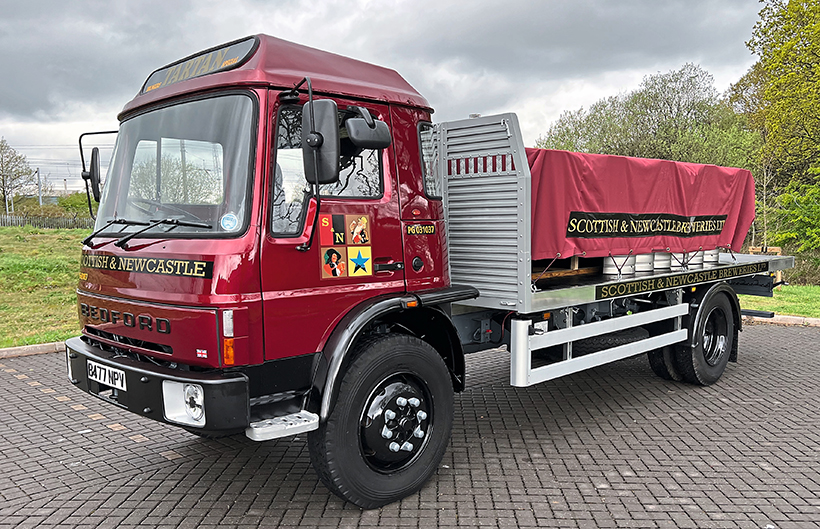
Pete Greive’s Bedford TL was originally a cattle float, but has been restored to replicate a Scottish & Newcastle Brewery dray of the 1980s.
Back in the 1970s, Bedford lorries were everywhere in the UK, and the famous TK was as common as muck. Just about any lorry driver of the era probably drove one, many people would have passed their HGV Class 3 test in them (and possibly their Class 1 as well). They did anything and everything.
But by the mid-1970s the TK was beginning to look a little dated. Bedford’s designers were, however, already on the case, and in early 1980, its replacement was unveiled – the TL. Initially the TK and TL were sold side-by-side and it was even Bedford’s intention the TL would merely complement its predecessor, but the in the end, TK ended production in the early 1980s.
Sadly the TL was effectively doomed from the start as it was launched in the height of a nationwide recession which meant sales were slow from the start as companies looked to tighten their purse strings and big investments such as in new lorries were often simply curtailed.
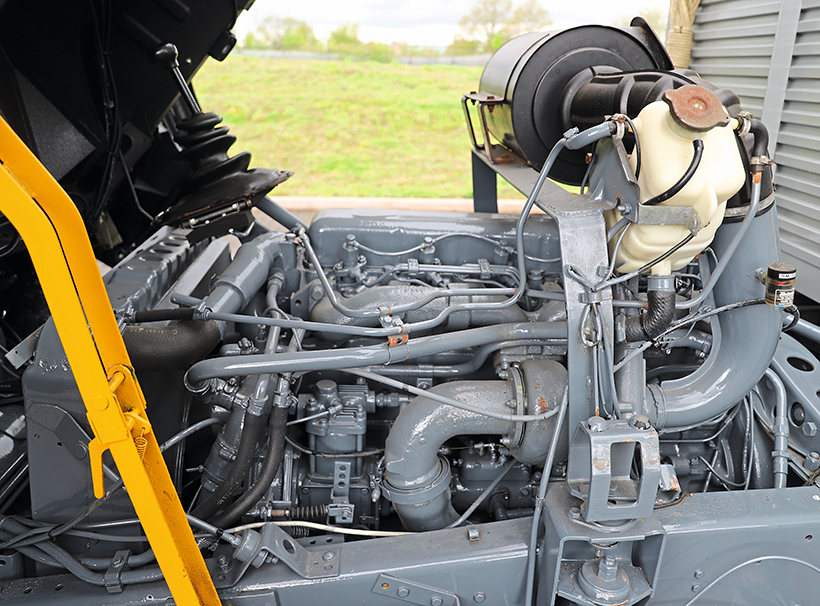
Engine has been cleaned up and painted, but hasn’t been touched mechanically.
The TL shared a lot of parentage with its predecessor. It had the same style of roomy day cab with a shelf behind the seats; this wasn’t big enough to be a proper sleeper cab, though drivers did sleep in them. It was, though, roomier than its arch-rival, the Ford D series and its replacement, the Cargo. And unlike the TK’s cab, the TL’s could tilt.
The TL was a more refined version of the TK, with a smoother, more pleasant appearance. It was available as a 6-tonner, incredibly popular as a 7½-tonner but also available right up to a 32-tonne artic. As a 16-tonner, it had a lot of competition for sales, not only from Ford, but also from Leyland and a growing contingent of European imports.
But it was a very popular lorry, especially with the big British industries, and one sector when the TL was warmly received was a dray lorry, delivering beer barrels to pubs for the country’s mass of large breweries.
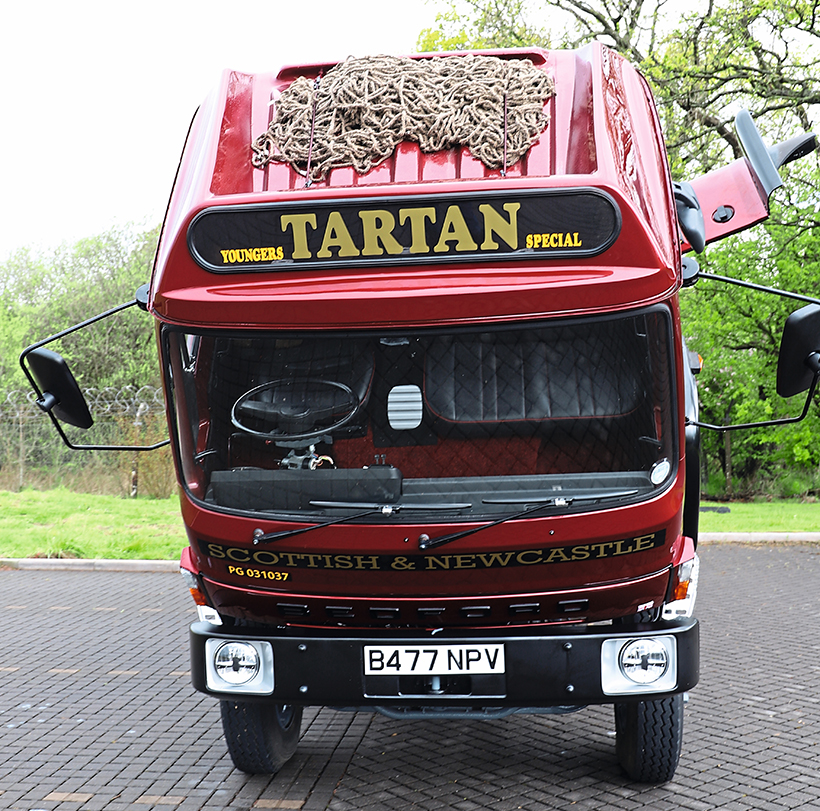
Unlike the TK’s, the TL’s cab tilted. The cab cap was a very lucky find during the restoration.
Dray lorries in the 1970s weren’t the same as they are today, there were no low height platforms, no tail-lifts, no curtains. Barrels – which were very heavy – were loaded by hand, so naturally, the draymen had to unload them by hand.
A stunning Bedford restored as a dray lorry, in the iconic 1980s livery of Scottish & Newcastle, caught my eye a while back and a chance conversation with the owner, Pete Grieve, on Facebook, meant I was able to go and see the lorry in Carlisle when I was returning from a week in Scotland.
The lorry is a TL1250 4×2 12-tonner and dates from 1984, a time when British lorries were still produced en masse, and still popular with many industries. Under the cab is the Bedford 500 engine.
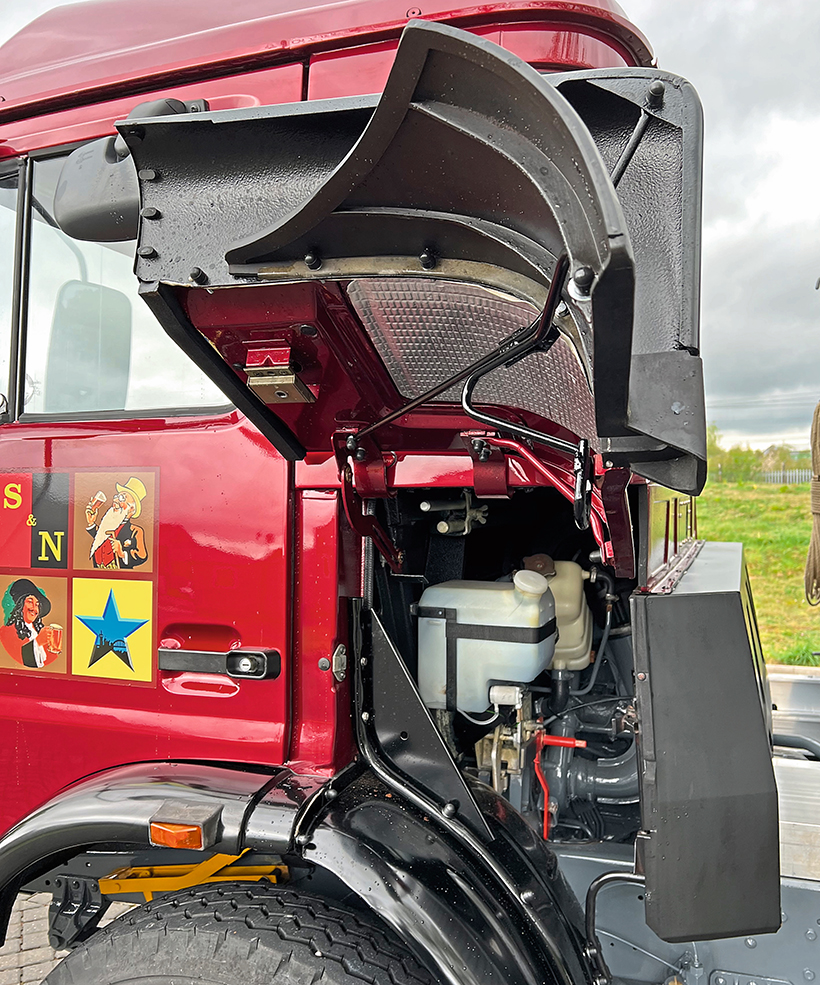
Despite the tilting cab, some routine servicing is still via TK-style side flaps.
Dad’s lorry recreated
Pete tells me the story behind the lorry, and more importantly, the livery. Pete isn’t, nor ever has been, a lorry driver. Nor has he ever been involved in the brewery trade, so why firstly, buy a lorry, and secondly deck it out as a dray wagon?
Pete takes up the story: “My father drove for Scottish & Newcastle for 15 years, working out of Carlisle. He retired from there, but sadly he died in 2020 aged 73.

Cab fully tilted, giving excellent mechanical access.
“I always wanted to restore a dray lorry in his firm’s livery as a tribute to his work, and I was trying to do it while he was alive and surprise him with the finished result. But sadly his passing meant he never saw it, but it did spur me on to finish it as a tribute.”
The TL was a hugely popular lorry and even though it’s over 35 years since the last ones were built by Bedford, I’d venture there are still many rusting in barns yards and fields in varying conditions.
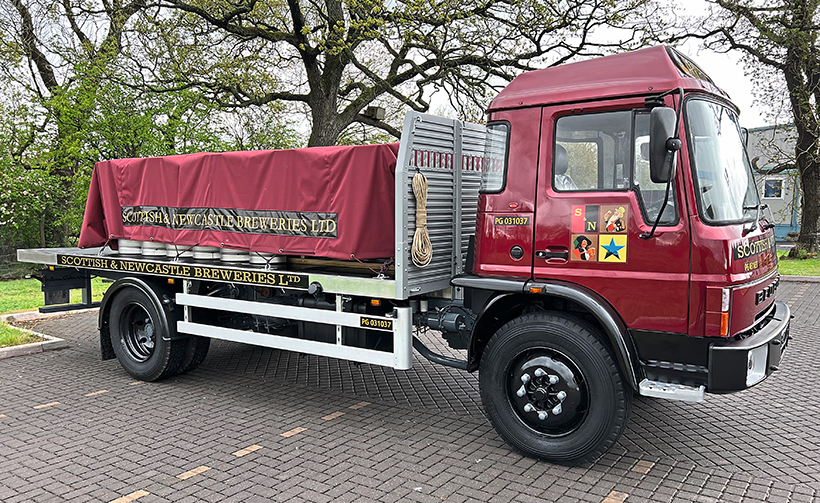
Side view shows amazing attention to detail; sadly the ‘beer’ load is 100% fake!
Pete found his example in Lincolnshire. “I saw it on Facebook. It cost me £2,000 but it was in pretty poor condition as it had been sat outside for 25 years!” Lorries like this don’t like being out in the elements for too long, and 25 years is challenging for any vehicle!
Adds Pete: “The body was rotten, and it needed a new cab.” Although Bedford finished production of the TL in 1986 (in fact Bedford finished building lorries full stop that year), the TL had two limited reprieves. In 1988, AWD bought the design rights, jigs and other things needed and restarted production of the TL, but that only lasted for four years until AWD ran into financial difficulties and production stopped in June 1992.
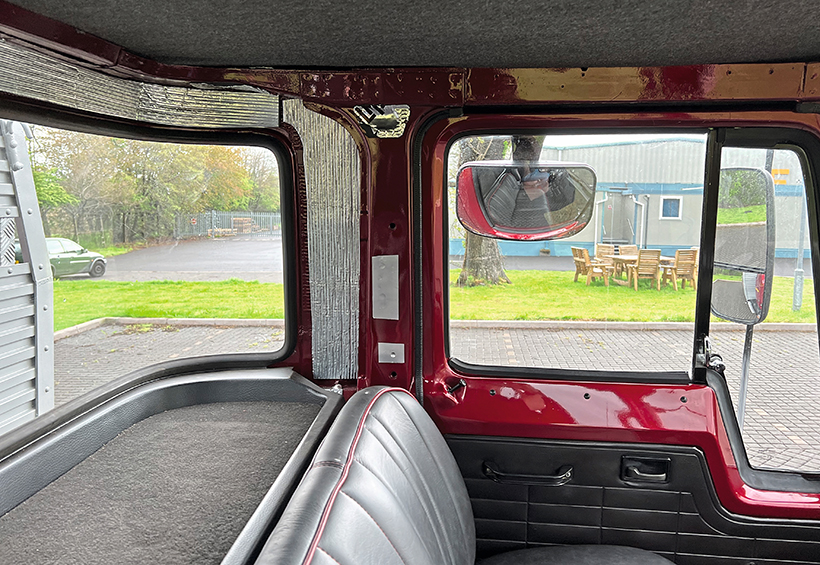
Cab shelf – the TL cab was a spacious day cab, but no sleeper.
Then, in October 1992, another company, Marshall SPV of Cambridge bought the AWD company – and the rights to the Bedford name, which AWD hadn’t used – and again had a go a reigniting TL production, reusing the Bedford name, but only a handful were built and the project was ultimately doomed. Interestingly, a 1996-built example had lain unregistered for several years after being a company display vehicle but was then snapped up on the cheap in 2001 by Croft Brothers and registered in 2002.
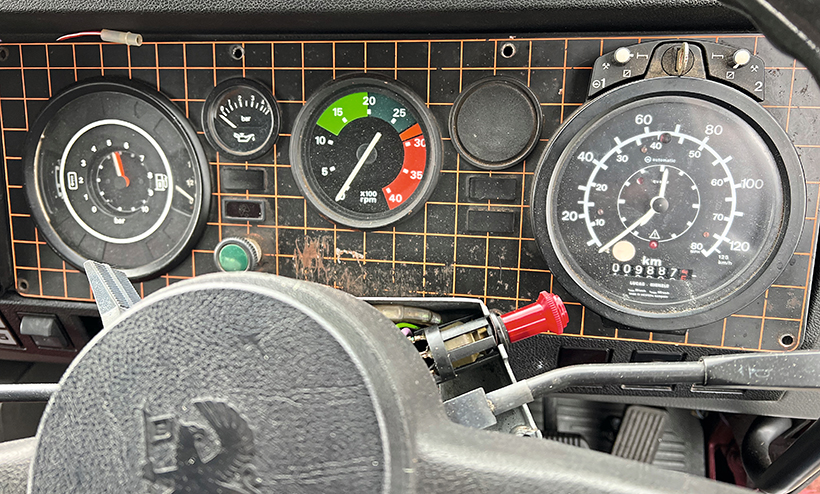
Dash instruments, including a correct, period analogue tachograph which would have been fitted from new in a 1984 lorry.
The problem was that by the mid-1990s the TL product was very dated, and not a patch on the Leyland DAF 65, Scania P94, Mercedes Atego, Foden Alpha and Iveco EuroCargo. Even the dated MAN F2000, ERF E series and Seddon Atkinson Strato2 were better products than the TL. The TL was – presumably – cheaper but it failed to capture the imagination, and the wallets, of hauliers and the TL was finally, for the third time, snuffed out in the mid-1990s.
A new cab
But, getting back to our story, Bedford’s ultimate demise was Pete’s gain as he was able to source and brand new, never used TL cab at an auction in Enniskillen, Northern Ireland. “It cost me £2000 but saved me a lot of work and expense, so it was a bargain.” The new cab was a massive, massive boost, and it was a real stroke of luck to secure it.”
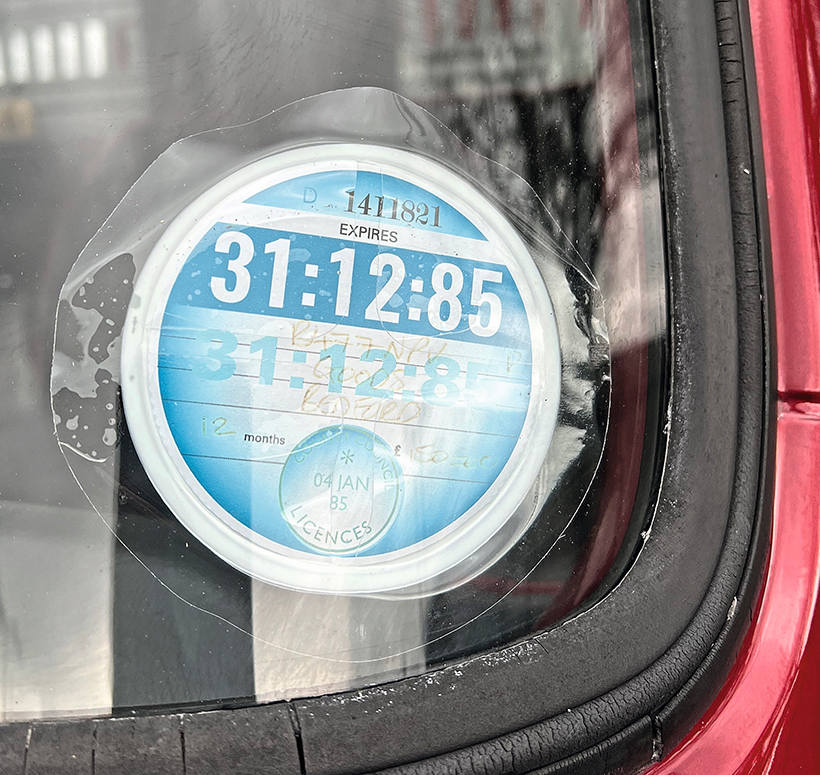
Correct period tax disc; the lorry was registered at the end of 1984, so the first tax disc would have expired one year later.
With a new cab sourced, it made the project a real goer, and Pete set about getting the lorry restored. “I had the chassis shot blasted and then painted.” Pete manufactured the dray body himself which left the driveline to sort. Here there was a stroke of luck. “The engine is the original and has not been touched bar the oil and filter changes. Both axles are also original too.”
“I was desperate to get a cab cap with the headboard, a common feature on TL (and indeed TKs) ‘back in the day’. Brewery lorries frequently had them. They are made out of glassfibre and here I had another stroke of luck, I was looking on the Bedford page on Facebook and I was offered one for £200! The cab cap has been the hardest part to source, so I was very pleased when I got one.”
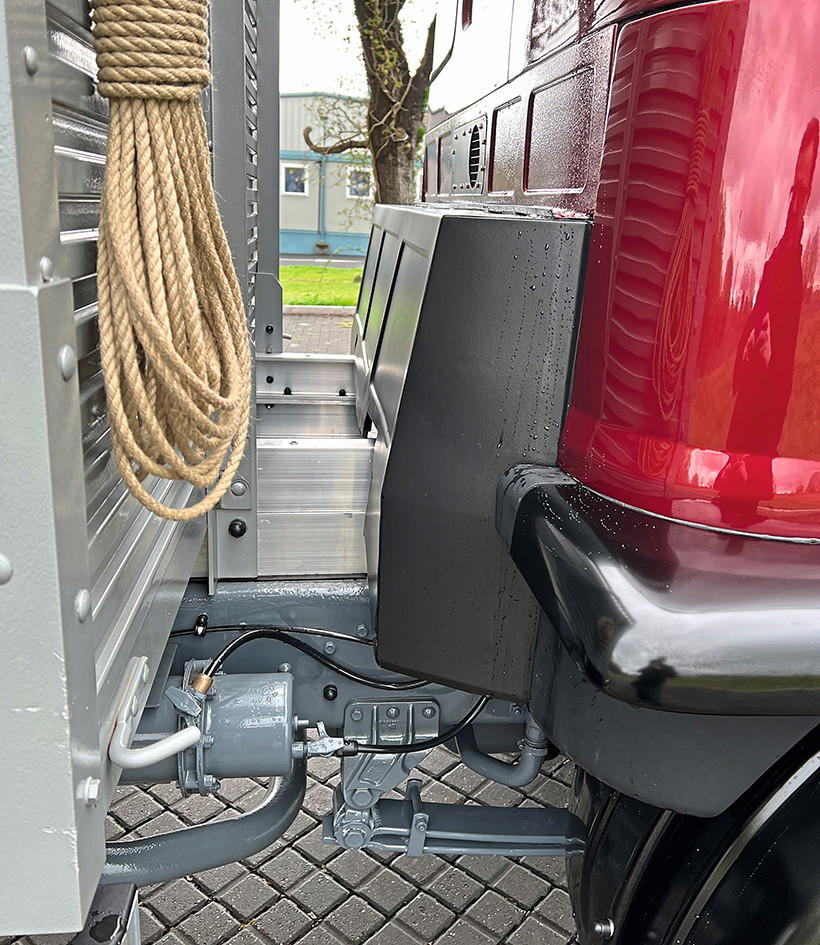
Fabulous finish and attention to detail are a hallmark of this lorry.
There are still many ‘hard to get’ parts and Pete regularly trawls the internet and will snap up anything he feels he may need in the future. “I found some cab rubbers which were new and cost £50 each – that was a bonus.”
The TL has been fitted with more efficient, and more powerful LED headlights, though you’d be hard pushed to know that just by looking at the lorry.
As well as having made the body himself, Pete has fitted it out with a period load. “The beer barrels are fake!”, he laughs. “They were brand new and cut in half for display. I found a company who make boat sails in Montrose, and it was able to make me the fabric load cover. I also plan to get some beer crates for the ‘load’ as well.”
There is also an attention to detail that should be applauded; there are ropes and netting mounted in the cab roof on the cab cap behind the headboard, “these will be used to cover the crates when I get them,” he says. It was, though, common to store them on the cab roof when not needed by the draymen when hard at work.
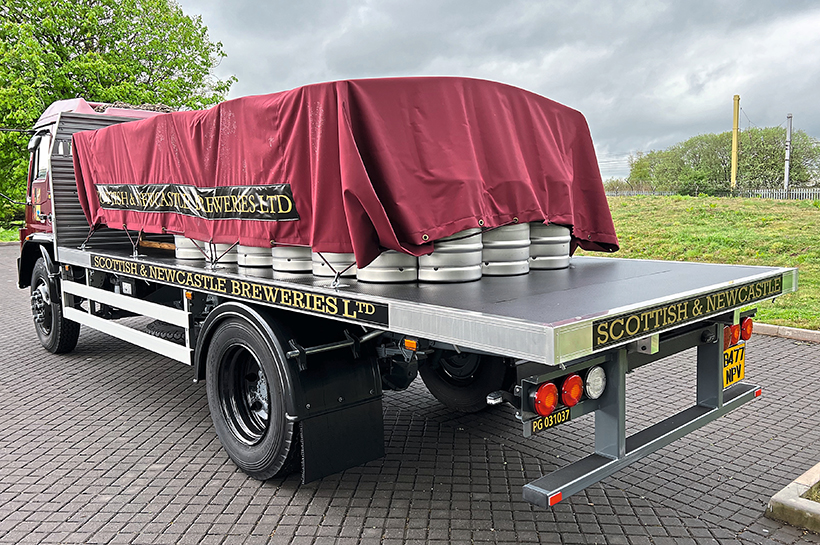
Rear view. Replica dray body was all the owner’s own work.
Pete’s father used to do between 12 and 15 deliveries a day to pubs, hotels and clubs throughout west Cumbria. “He loved his job,” says Pete with a smile.
There are still a few jobs left to do before it’s a 100% finished restoration. The tyres will need replacing if it is to go on the road, as no lorry should run on the road with types more than ten years old. But at the moment, Pete has no immediate plans to make it roadworthy, which is just as well, because presently, he can’t legally drive it because he has no HGV licence!
“I plan to change to tyres and get the lorry MoT’d and there are one or two other things to do on the interior trim and it needs a new window winding handle. The cab footsteps also need bolting into position – it’s a bit of a challenge to get inside the cab…. Well, safely at any rate!

The restoration
Pete says the restoration took about a year to get it to this condition. “The main delays were waiting for others to do odd bits, but I have done pretty much all of it myself. I interact with a lot of other Bedford owners on Facebook which helps me get parts or assistance.”
The lorry is nearly finished but it’s already attracting a lot of attention and Pete has even had a few offers to buy it “I was offered £40,000 but I turned it down, it’s too personal to me.” He says he thinks he will have spent ‘about £29,000’ buying it and restoring it.
It was originally a cattle lorry, and its registration suggests it was new to a haulier in Essex. The replacement cab he sourced was left hand drive and needed the dash, handbrake, gear lever and wipers all converting to be suitable for right hand drive.
The new roof skin was welded on, and he made a headboard out of fibreglass before he found the cab cap. The original cab had the earlier indicators, but the newer cab had the later design which are the right ones for this model and era. “I wanted the new grille and indicators. The lorry was one of those with the original 1980-style grille.”
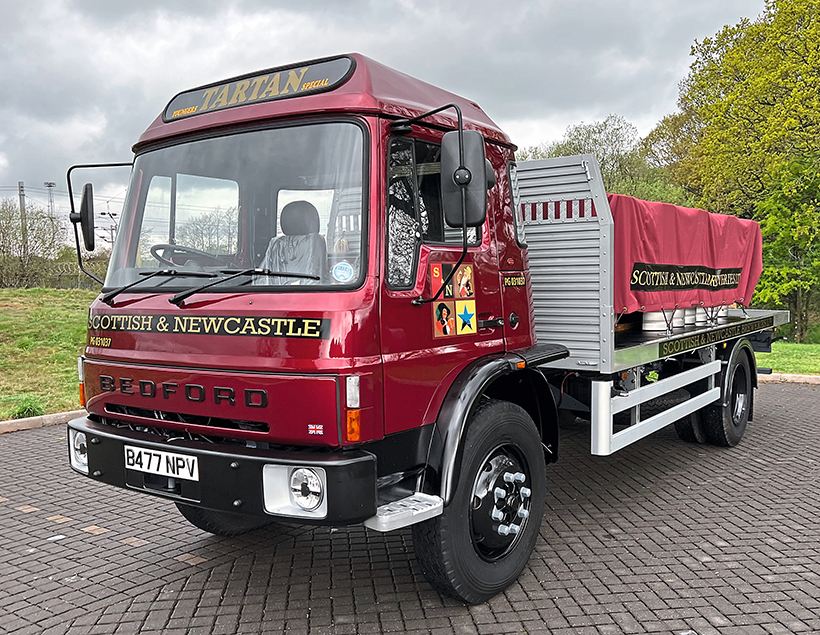
The seats are the originals, but they have been re-covered in new, authentic fabric, although that cost a cool £2000 to achieve. The mudguards are the originals from when the lorry was new, but needed some level of repair. “I was able to source a lot of the parts locally,” Pete adds. “It was also shot blasted in nearby Longtown, and the aluminium body was from Newcastle.”
One thing about this TL is it’s not just a case of restoring any old TL. From the start, Pete didn’t want a lorry for the sake of having a lorry, he wanted a TL in the colours of his dad’s employer as a tribute to him. And to do that he needed the right artwork. “I got a design for the Scottish & Newcastle logo and a lad who works for me designed it from what we found on the internet.
Pete’s finished truck is a beauty – and it’s nice to see attention has been paid to returning it to an authentic livery, made all the better by it carrying an appropriate load.
This feature comes from the latest issue of Classic Vintage & Commercials, and you can get a money-saving subscription to this magazine simply by clicking HERE

Previous Post
Escobar’s steam engines found in Columbian theme park!

Next Post
A superbly-restored 1969 Massey Ferguson 135



